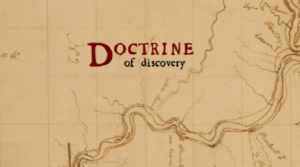Finders keepers – The Doctrine of Discovery
*Previously published in the North Grenville Times on July 10, 2019.
Imagine a typical Canadian family packing up and heading off to the cottage for a few days. Naturally, it’s beside a lake, very rough and ready, no hydro or running water – just how they like it. Imagine, also, their shock on arriving at the isolated spot to find a U.S. flag flying outside of their cottage, which is occupied by Americans. On challenging the trespassers, the Canadians are told that the Americans have every right to occupy the cabin, since it was not properly maintained, developed, or otherwise made use of. A rather unlikely scenario, perhaps? Yet, that is precisely what happened when Europeans “discovered” Canada. The few sailors who came ashore in a small boat immediately claimed the land on behalf of their King (an English one in 1497, and a French one in 1524).
Completely ignoring the fact that there were people already settled in the “newly discovered” lands, people with a long history and sophisticated culture, the Europeans rationalised their claim by pointing out that the inhabitants had not “properly” used the land they roamed, and that the highest authorities had granted to Europeans the right to claim such territory. On the face of it, the arrogance (not to mention ignorance) of the Europeans is astounding. It was like the old nursery rhyme: “Finders keepers, losers weepers”. But this is no nursery rhyme; this is Canadian history, and the daily life of many thousands of Indigenous people in this country ever since those fateful sailors arrived on these shores.
Behind it all is what is known as the “Doctrine of Discovery”, a claim that goes back to the time of the first exploration of North America by Europeans. Shortly after the first voyage of Columbus in 1492, it was recognised that there were territories to the west and south, in the Americas, Asia and Africa that could be exploited by Europeans— lands that promised great wealth to those who could get their hands on it. Therefore, on May 4, 1493, Pope Alexander VI issued a Papal Bull (Decree) entitled Inter Caetera, “Among other things”, which granted his gracious permission to European monarchs to lay claim to any territory their subjects might discover, as long as it was more than 100 leagues to the west or south of European lands. He did this, he claimed “out of the fullness of our apostolic power, by the authority of Almighty God conferred upon us in blessed Peter and of the vicarship of Jesus Christ, which we hold on earth”. So it was, that, on landing on this huge landmass on the other side of the Atlantic, this handful of Europeans, in their ignorance and arrogance, laid claim to everything in the name of a European monarch.
When the British Crown conquered the French Crown in Canada in 1760, the British King simply assumed title to what had been the “property” of the French King, by right of conquest. However, he had not conquered the Indigenous people at any time, nor did any subsequent monarch in Canada. In 1763, in issuing a Royal Proclamation detailing how the newly acquired territories would be administered, the British King drew a line on the map, running roughly from Lake Nipissing to Cornwall, beyond which was “Indian Territory”. But even that vast and still relatively unknown land was nevertheless claimed by the King, who graciously allowed the Indigenous people to remain there under his jurisdiction.
“And We do further declare it to be Our Royal Will and Pleasure, for the present as aforesaid, to reserve under our Sovereignty, Protection, and Dominion, for the use of the said Indians…all the Lands and Territories lying to the Westward.”
From the moment the Pope issued his Bull in 1497, up to the present day, monarchs of Europe, and in particular Great Britain, have laid claim to the lands that now comprise the Dominion of Canada. The rights and freedoms of the Indigenous peoples of the territory were restricted and confined to whatever that monarch and their governments chose to allow them. Even after the Reformation, Protestant powers continued to act on this principle. Hence, in the Royal Proclamation of 1763, the Crown could claim title to lands even when “not having been ceded to or purchased by Us”. This Doctrine of Discovery is the basis on which the Crown claims title to all lands in Canada.
Although most Christian denominations have repudiated the Doctrine of Discovery and called for its repudiation by governments, it has been used in court cases to buttress government control over Indigenous people. It forms the bedrock for all Canadian law, including the Indian Act. Pope Francis has been officially requested by Indigenous groups around the world to formally repudiate the Doctrine, so far with no effect. The United Nations Declaration on the
Rights of Indigenous Peoples (UNDRIP), accepted by the Canadian Government, refutes the Doctrine of Discovery. In Senate hearings in May of this year, government officials declared that UNDRIP would not alter Canadian laws. It seems that a fifteenth century Papal Bull will continue to over-ride Canadian and international rights for Indigenous people.
The Doctrine of Discovery is the foundation for the colonisation of Canada’s Indigenous peoples, but it was not the only document which produced the situation we have today. Another foundational work was to be used, quoted and applied to the Indigenous peoples of Canada to further their submission to the Law of Nations.



